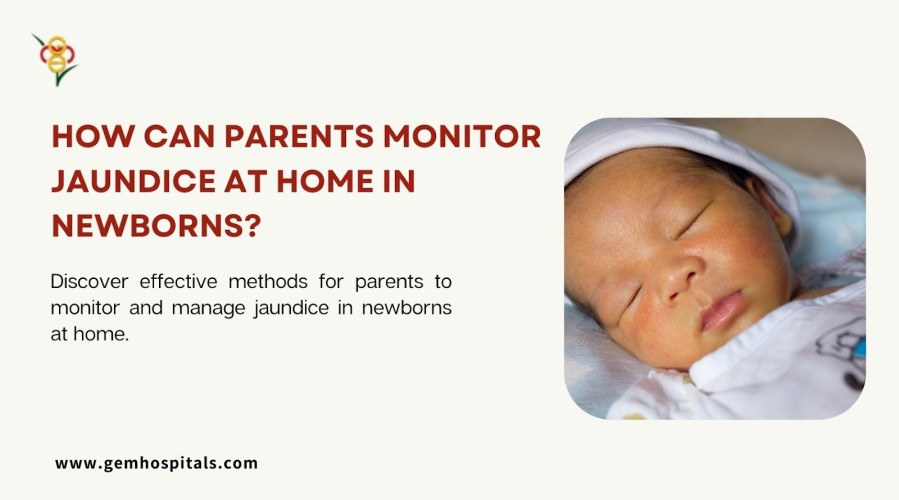Food poisoning is common during the monsoon. Learn when it becomes serious, how it can lead to pancreatitis or liver damage, warning signs, and when to seek medical care.
How Can Parents Monitor Jaundice at Home in Newborns

Jaundice is a common condition people are experiencing not only adults but newborns are also prone to getting jaundice. In fact, according to the report, about 60% of full-term infants and preterm babies are getting jaundice. The jaundice usually occurs when the bilirubin content increases in the body it will be identified by the yellowing of skin and eyes. In newborns the liver is not fully matured in that case it can’t process the bilirubin thus the process will be slower and the skin and eyes turn yellow. Even though it is harmless it requires a proper treatment to avoid turning them into serious ones. So it is crucial to observe the condition closely by the parents to prevent any potential complications. The content below aims to provide essential tips for parents on how to monitor jaundice in their newborns at home.
Understanding newborn jaundice
Usually, the jaundice appears in newborns in the first few days of birth and the level of bilirubin peaks during the fourth or fifth day but it automatically declines as the liver matures and starts the processing of bilirubin levels in the blood. However, in some cases, the level of bilirubin keeps shooting up which is not a normal thing it may lead to serious complications like kernicterus, a type of brain damage caused by very high levels of bilirubin.
Recognizing the signs of jaundice
The first and most easy step to monitor jaundice at home is recognizing the signs and symptoms. Here’s what to look for,
- The simple but most noticeable sign of jaundice is the yellowing of skin and eyes. This yellowing usually starts on the face and then spreads to the chest, abdomen, arms, and legs as bilirubin levels increase.
- Noticing the urine color is vital when the color of urine is dark that indicates a higher level of bilirubin in the blood.
- Like urine, when a baby’s stool is pale or dark in color then it may be an indication of jaundice this shouldn’t be taken easily it is time to consult a doctor.
- Generally, newborns sleep a lot but when they are sleeping excessively and feeling difficulty in feeding then it may be also an indication of jaundice.
Monitoring jaundice at home
When you suspect that your newborn may infected with jaundice or diagnosed with jaundice here are the things you have to do to monitor the jaundice at home,
- Monitoring the baby’s skin color in natural light at least once a day is vital. Give a slight press to your baby’s skin gently, particularly on the forehead, nose, or chest if it appears yellow take them to the doctor for further diagnosis.
- It is vital to check the feeding activity of newborns because when they are unwell they feel difficulty in feeding and also look at the diaper to know the color of urine and stool. When the bilirubin level is high the urine and stool color will be darker.
- Usually, newborns sleep a lot so to observe whether they are normal note their sleeping patterns of them. They should still wake up every two to three hours to feed. If your baby is excessively sleepy or not feeding well, it may be a sign that jaundice is worsening.
When to seek medical attention?
In newborns jaundice are normal it will fade off in the next few days but still it is vital to know when you require medical attention. Check the following, skin and eyes of the baby, urine and stool color, and sleep patterns. The changes in them indicate jaundice get proper help from a healthcare practitioner and safeguard your newborn from the condition.
Even though jaundice is common proper monitoring is required to keep the newborns under safe condition. Always visit your healthcare practitioner if you have any concerns or questions about your baby’s condition.
For effective jaundice treatment, trust GEM Hospital’s experienced specialists. Receive personalized care and advanced solutions. Schedule your consultation now for comprehensive health management.
Blogs & Article
UTI cases often rise during the rainy season. Learn why urology patients need extra precautions, common causes, symptoms, and prevention tips to stay healthy during monsoon.
Monsoon humidity can worsen endometriosis pain and bloating. Learn how weather changes affect symptoms and discover practical tips to manage discomfort during the rainy season.


